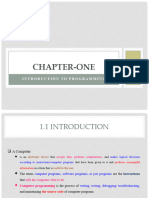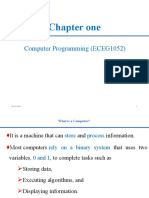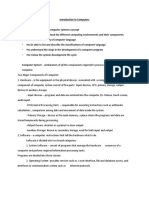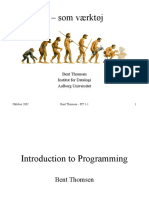0 ratings0% found this document useful (0 votes)
22 viewsStructure of Programming Languages Module 2 Read Only
This document discusses various programming paradigms and considerations for structured programming. It describes programming paradigms as fundamental styles of programming that differ in concepts and abstractions used. Specific paradigms mentioned include unstructured, modular, object-oriented, visual, and internet-based programming. It also discusses hardware and software considerations for structured programming, including the interaction of hardware components during program execution. Finally, it covers factors to consider when choosing a programming language and the key aspects of program development and design.
Uploaded by
Zyra MabungaCopyright
© © All Rights Reserved
Available Formats
Download as PPTX, PDF, TXT or read online on Scribd
0 ratings0% found this document useful (0 votes)
22 viewsStructure of Programming Languages Module 2 Read Only
This document discusses various programming paradigms and considerations for structured programming. It describes programming paradigms as fundamental styles of programming that differ in concepts and abstractions used. Specific paradigms mentioned include unstructured, modular, object-oriented, visual, and internet-based programming. It also discusses hardware and software considerations for structured programming, including the interaction of hardware components during program execution. Finally, it covers factors to consider when choosing a programming language and the key aspects of program development and design.
Uploaded by
Zyra MabungaCopyright
© © All Rights Reserved
Available Formats
Download as PPTX, PDF, TXT or read online on Scribd
You are on page 1/ 47
Content, Programming Paradigms,
Hardware and Software
Considerations for
MODULE 2
Programming Paradigms 1
A PROGRAM PARADIGM IS A FUNDAMENTAL STYLE OF
COMPUTER PROGRAMMING.
A METHODOLOGY IS A STYLE OF SOLVING SPECIFIC
SOFTWARE ENGINEERING PROBLEMS.
PARADIGMS DIFFER IN THE CONCEPTS AND
ABSTRACTIONS USED TO REPRESENT THE ELEMENTS
OF A PROGRAM AND THE STEPS THAT COMPOSE THE
COMPUTATIONS.
Some example of programming paradigms include:
• Unstructured programming
• Modular/Structured programming
• Object- oriented programming
• Visual programming
• Internet based programming
Unstructured programming
THIS IS A PROGRAMMING TECHNIQUE IN WHICH
STATEMENTS ARE WRITTEN, ORDERED AND EXECUTED
SEQUENTIALLY FROM THE FIRST TO THE LAST IN THE
ORDER THEY APPEAR ON THE EDITOR.
IT ’S ALSO CALLED NON-STRUCTURED OR MONOLITHIC
PROGRAMMING.
IT IS HISTORICALLY THE EARLIEST PROGRAMMING
PARADIGM.
Modular/Structured
programming
THIS IS A PROGRAMMING TECHNIQUE THAT ENABLES
LARGE PROGRAMS TO BE BROKEN DOWN INTO
MODULES THAT PERFORM A PARTICULAR TASK USING
SIMPLE CONTROL STRUCTURES IN PROBLEM SOLVING,
AND THEN THESE MODULES ARE INCORPORATED
INTO THE MAIN PROGRAM THROUGH INTERFACES.
Object- oriented programming
OBJECT ORIENTED PROGRAMMING IS A PROCESS BY
WHICH A PROGRAM IS ORGANIZED INTO OBJECTS
WITH EACH OBJECT CONTAINING BOTH THE DATA
AND THE PROCESSING OPERATIONS NECESSARY TO
PERFORM A TASK.
The structure, or building blocks, of object-oriented
programming include the following:
Classes
• Are user defined data types that act as the blueprint for individual objects, attributes and methods.
Objects
• are instances of a class created with specifically defined data. Objects can correspond to real-world
objects or an abstract entity. When class is defined initially, the description is the only object that is
defined.
Methods
• are functions that are defined inside a class that describe the behaviors of an object. Each method
contained in class definitions starts with a reference to an instance object. Additionally, the subroutines
contained in an object are called instance methods. Programmers use methods for reusability or
keeping functionality encapsulated inside one object at a time.
Attributes
• are defined in the class template and represent the state of an object. Objects will have data stored in
the attributes field. Class attributes belong to the class itself.
Visual programming
THIS IS AN EVENT DRIVEN STYLE IN WINDOWS THAT
IS BASED ON READYMADE OBJECTS WHICH
COMPRISES OF A COLLECTION OF PROCEDURES THAT
RESPONDS TO OTHER PROCEDURES THAT PERFORMS
SPECIFIC TASKS.
There are n numbers of visual programming languages
and the few which are in the top list is given below
• Scratch: With the help of this language users can create, stories,
games, and animations without writing any lines of code in this you
just have to create the logic and assemble the blocks.
• Blockly: Used to create block-based programming language and
editors, and also to generate code from blocks to javascript lua dart
python and PHP, etc.
• mBlock language: It is used in programming robots.
• Bubble language: It is used to create web applications.
• Minibloq language: It is used as a graphical programming
environment for Arduino.
Internet based programming
THIS IS A PROGRAMMING PARADIGM THAT ENTAILS
THE PROCESS OF DESIGNING WEBSITES AND WEB
PAGES THAT ARE PART OF PARCEL OF THE INTERNET.
IN THIS CASE, VARIOUS PROGRAMMING LANGUAGES
ARE USED TO DESIGN BOTH THE CLIENT-SIDE AND
THE SERVER-SIDE INTERFACES.
Hardware and Software Considerations for Structured
Programming
• Hardware - is the equipment used to in performing the necessary
functions during programming and in the execution of programs.
• Software - consists of the programs that enable us to solve
problems with a computer by providing it with lists of instructions
to perform.
The various hardware components interact as follows
during program execution:
• The program must first be transferred from secondary storage to main
memory before it can be executed.
• Normally the person using a program (the program user) must supply
some data to be processed.
• These data are entered through an input device and are stored in the
computer’s main memory, where they can be accessed and manipulated
by the central processing unit.
• The results of this manipulation are then stored back in main memory.
• Finally, the information in main memory can be displayed through an
output device.
The various hardware components interact as follows
during program execution:
• Processor Speed
• Memory Capacity
• Warranty
• Cost
• Upgradeability
• Compatibility
• Portability
• Users’ needs
Software is generally classified as:
• System software – set of programs that are used to manage
computer resources and it’s composed of Operating System,
Network software, Utility software and Firmware
• Application Software – this is a set of programs that are used by a
computer user or programmer to perform certain tasks with the
computer. These programs are categorized as follows depending on
the task they perform: Programming languages, Tailor made
software and Vendor-off-the-shelf software.
So, the factors to be considered in choosing a
programming language are:
• Programmer’s experience
• The nature of the application being developed
• User friendliness.
• Features of the language.
• Programming paradigms it supports
• Reliability
So, the factors to be considered in choosing a
programming language are:
• Compatibility
• System requirements
• Upgradeability
• Documentation
• Security
• Cost
Program Development and
Design
CONTENT
• Meaning of Program development and design
• Program development Life cycle:
1. Problem recognition
2. Problem definition
Meaning of Program Development and Design
Development
Development is the act of improving by expanding or enlarging or
refining
Program development
is an ongoing systematic process that programmers follow as they
try to come up with sets of instructions that can be executed by a
computer to solve some of the complex problems that human
beings would either take too long to solve manually, or they would
not be able to solve at all.
In fact, the four main activities involved in
programming are:
1. Designing and testing an algorithm as a solution to a problem.
2. Calling algorithm into a computer program using appropriate
language.
3. Testing the computer program to find out whether it solves the
problem
4. Documenting the computer program so that it can be maintained
by others at a later date.
The main functions of a computer program
are to process data into information.
A computer program therefore performs the following
activities:
1. Accepts data from outside the computer as input
2. Carries out a set of processes on the data within the computer
memory .
3. Stores the data for future use
4. Presents the results of this processing as its output
In order to come up with a solution to a problem we
must:
1. Have a clear understanding of the problem
2. Determine what we need to help solve the problem
3. Decide what results we want to achieve
4. Consider different ways to achieve our result and select the best
one
5. Then we must come up with a step-by-step sequence of
instructions to be followed to achieve a solution o the problem
Therefore, during the process of developing
the program, one should ensure that the
correct requirements are identified at each
stage before the next stage is initiated.
Otherwise, the method of developing the
program may be very expensive.
Program design
THIS IS THE ACTUAL DEVELOPMENT OF THE
PROGRAM'S PROCESSING OR PROBLEM SOLVING
LOGIC CALLED THE ALGORITHM THAT ENABLES THE
PROGRAMMER TO COME UP WITH MODELS OF THE
EXPECTED PROGRAM.
THE MODELS SHOW THE FLOW OF EVENTS AND DATA
THROUGHOUT THE ENTIRE PROGRAM FROM THE
TIME THE DATA IS INPUT TO THE TIME THE PROGRAM
GIVES OUT THE EXPECTED INFORMATION.
Therefore, program design involves developing the method of
solving the problem by planning and creating a solution using
structured programming techniques such as top-down program
design, pseudo code, flowcharts, control structures, decision
tables and decision trees.
In program design, the programmer identifies the processing
tasks required, and the precise órder in which they are to be
which the computer
carried out, that is an algorithm from which the computer program
will be produced
In order to come up with a solution to a problem we
must:
Algorithm - is a sequence of instructions which, if followed, produces
a solution to the given problem and is written using special rules and
statements.
Pseudo Code - processing steps of a program or module.
Module - is a portion of the main program containing a group of
processing instructions performing a specific task.
Modular Programming - Modular programming involves developing
program informs of modules making it to be flexible, easier to read
and correct errors.
In order to come up with a solution to a problem we
must:
Flowchart - is a graphical representation of the steps needed to solve
the problem by using special symbols that have specific meaning and
short statements.
Control Structures - are blocks of statements that determine the order
of execution of statements in a program
A detailed design must define the following:
1. Data structures - defining the format and type of data the program
will use.
2. User interface- the design of the screen the user will see and use
to enter data or display data
3. Inputs - defining the kind of data to enter into the program.
4. Outputs - the possible data displayçd from the system
5. Algorithms methods of calculating outputs depending on inputs.
Programming Developnent
Life Cycle (PDLC)
THIS IS A RECOMMENDED SERIES OF STEPS THAT
ARE SUPPOSED TO BE FOLLOWED WHEN
DEVELOPING A PROGRAM. THEREFORE, BEFORE
COMMITTING ONESELF INTO WRITING A
PROGRAM, THE FOLLOWING ARE THE STEPS
THAT MUST BE FOLLOWED AND THEY FORM A
PROGRAM DEVELOPMENT LIFECYCLE (PDLC):
Therefore, in order to develop a program that can adequately
solve the problem at hand, a programmer has to:
1. Specify the problem requirements.
2. Analyze the problem.
3. Design the algorithm to solve the problem.
4. Implement the algorithm.
5. Test and verify the completed program.
6. Maintain and update the program.
Specifying the problem requirements
• Specifying the problem requirements forces you to state the
problem clearly and unambiguously and to gain a clear a
understanding of what is required for its solution.
• Your objective is to eliminate unimportant aspects and zero in on
the root problem.
• This goal may not be as easy to achieve as it sounds. You may find
you need more information from the person who posed the
Analyze the problem
• Inputs, that is, the data you have to work with
• Outputs, that is, the desired results
• Any additional requirements or constraints on the solution.
Design the algorithm to solve the problem
• Designing the algorithm to solve the problem requires you to
develop a list of steps called an algorithm to solve the problem and
to then verify that the algorithm solves the problem as intended.
• Writing the algorithm is often the most difficult part of the problem-
solving process.
NOTE: Don't attempt to solve every detail of the problem at the
beginning: instead, discipline yourself to use top-down design.
In top-down design (also called divide and conquer). you first
list the major steps, or sub problems, that need to be solved.
Then you solve the original problem by solving each of its sub
problems
Implement the algorithm
• Implementing the algorithm (step 4 in the software development
method) involves writing it as a program.
• You must convert each algorithm step into one or more statements
in a programming language.
Test and verify the completed program.
• Testing and verifying the program requires testing the completed
program to verify that it works as desired.
• Don't rely on just one test case.
• Run the program several times using different sets of data to make
sure that it works correctly for every situation provided for in the
algorithm.
Maintain and update the program.
• Maintaining and updating the program involves modifying a
program to remove previously undetected errors and to keep it up-
to-date as government regulations or company policies change.
• Many organizations maintain a program for five years or more,
often after the programmers who originally coded it have left or
moved on to other positions,
NOTE: A disciplined approach is essential if you want to create
programs that are easy to read, understand, and maintain.
You might also like
- English File 4e Pre Int Culture Reading Comp Answer KeyNo ratings yetEnglish File 4e Pre Int Culture Reading Comp Answer Key3 pages
- Lecture Note 1. Introduction To Computer and ProgrammingNo ratings yetLecture Note 1. Introduction To Computer and Programming45 pages
- 28 Fresh ESL Vocabulary Words For SpringNo ratings yet28 Fresh ESL Vocabulary Words For Spring4 pages
- Continued On EEE211 (Electrical Engineering CourseNo ratings yetContinued On EEE211 (Electrical Engineering Course23 pages
- Lelsey Anne - Simple Program Design - A Step-by-Step ApproachNo ratings yetLelsey Anne - Simple Program Design - A Step-by-Step Approach43 pages
- 01 Topic 1 - Introduction To Computer Programming - RemovedNo ratings yet01 Topic 1 - Introduction To Computer Programming - Removed29 pages
- Introduction To Programming and AlgorithmsNo ratings yetIntroduction To Programming and Algorithms26 pages
- Program Development Life Cycle PRESENTATIONNo ratings yetProgram Development Life Cycle PRESENTATION37 pages
- Understanding Computer Programming 9&10No ratings yetUnderstanding Computer Programming 9&1053 pages
- Chapter 1-Introduction To Computer and ProgrammingNo ratings yetChapter 1-Introduction To Computer and Programming11 pages
- IT - Som Værktøj: Bent Thomsen Institut For Datalogi Aalborg UniversitetNo ratings yetIT - Som Værktøj: Bent Thomsen Institut For Datalogi Aalborg Universitet46 pages
- Introduction and Overview: 1.1 Computer OrganizationNo ratings yetIntroduction and Overview: 1.1 Computer Organization5 pages
- The Software Programmer: Basis of common protocols and proceduresFrom EverandThe Software Programmer: Basis of common protocols and proceduresNo ratings yet
- Algorithms Made Simple: Understanding the Building Blocks of SoftwareFrom EverandAlgorithms Made Simple: Understanding the Building Blocks of SoftwareNo ratings yet
- Software Testing Interview Questions You'll Most Likely Be AskedFrom EverandSoftware Testing Interview Questions You'll Most Likely Be AskedNo ratings yet
- Linux Firewall: For The Office and HomeNo ratings yetLinux Firewall: For The Office and Home53 pages
- Target: Before Proceeding Further, Check How Much You Know About BusinessNo ratings yetTarget: Before Proceeding Further, Check How Much You Know About Business16 pages
- Download full Animal Skeletons and Anatomy An Image Archive for Artists and Designers Kale James ebook all chapters100% (1)Download full Animal Skeletons and Anatomy An Image Archive for Artists and Designers Kale James ebook all chapters34 pages
- Advantages and Disadvantages of TechnologyNo ratings yetAdvantages and Disadvantages of Technology1 page
- Sell ClickBank Products Using Ebay Classified Ads. (PDFDrive)No ratings yetSell ClickBank Products Using Ebay Classified Ads. (PDFDrive)112 pages
- Cathodic Protection of Reinforced Concrete Distance LearningNo ratings yetCathodic Protection of Reinforced Concrete Distance Learning4 pages
- ETG22 - Safe Use of Industrial Organic SolventsNo ratings yetETG22 - Safe Use of Industrial Organic Solvents8 pages
- Orthodontic Preparation For Orthodontic SurgeryNo ratings yetOrthodontic Preparation For Orthodontic Surgery15 pages
- Dr. Fusina DRDC Bi-Toroid Transformer Data 24-10-09No ratings yetDr. Fusina DRDC Bi-Toroid Transformer Data 24-10-092 pages
- Rethinking Resistance: (S. Ramnarayan and Christian Harpelund)100% (1)Rethinking Resistance: (S. Ramnarayan and Christian Harpelund)12 pages
- English File 4e Pre Int Culture Reading Comp Answer KeyEnglish File 4e Pre Int Culture Reading Comp Answer Key
- Lecture Note 1. Introduction To Computer and ProgrammingLecture Note 1. Introduction To Computer and Programming
- Continued On EEE211 (Electrical Engineering CourseContinued On EEE211 (Electrical Engineering Course
- Lelsey Anne - Simple Program Design - A Step-by-Step ApproachLelsey Anne - Simple Program Design - A Step-by-Step Approach
- 01 Topic 1 - Introduction To Computer Programming - Removed01 Topic 1 - Introduction To Computer Programming - Removed
- Chapter 1-Introduction To Computer and ProgrammingChapter 1-Introduction To Computer and Programming
- IT - Som Værktøj: Bent Thomsen Institut For Datalogi Aalborg UniversitetIT - Som Værktøj: Bent Thomsen Institut For Datalogi Aalborg Universitet
- Introduction and Overview: 1.1 Computer OrganizationIntroduction and Overview: 1.1 Computer Organization
- Software Design And Development in your pocketFrom EverandSoftware Design And Development in your pocket
- The Software Programmer: Basis of common protocols and proceduresFrom EverandThe Software Programmer: Basis of common protocols and procedures
- Algorithms Made Simple: Understanding the Building Blocks of SoftwareFrom EverandAlgorithms Made Simple: Understanding the Building Blocks of Software
- Software Testing Interview Questions You'll Most Likely Be AskedFrom EverandSoftware Testing Interview Questions You'll Most Likely Be Asked
- Target: Before Proceeding Further, Check How Much You Know About BusinessTarget: Before Proceeding Further, Check How Much You Know About Business
- Download full Animal Skeletons and Anatomy An Image Archive for Artists and Designers Kale James ebook all chaptersDownload full Animal Skeletons and Anatomy An Image Archive for Artists and Designers Kale James ebook all chapters
- Sell ClickBank Products Using Ebay Classified Ads. (PDFDrive)Sell ClickBank Products Using Ebay Classified Ads. (PDFDrive)
- Cathodic Protection of Reinforced Concrete Distance LearningCathodic Protection of Reinforced Concrete Distance Learning
- Dr. Fusina DRDC Bi-Toroid Transformer Data 24-10-09Dr. Fusina DRDC Bi-Toroid Transformer Data 24-10-09
- Rethinking Resistance: (S. Ramnarayan and Christian Harpelund)Rethinking Resistance: (S. Ramnarayan and Christian Harpelund)
























































































